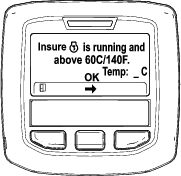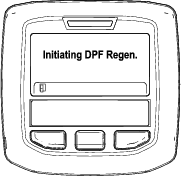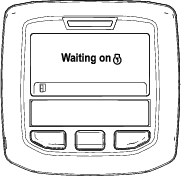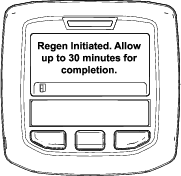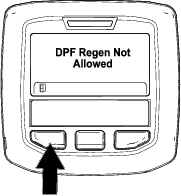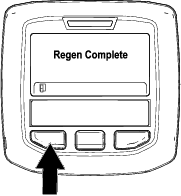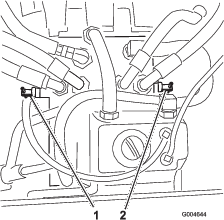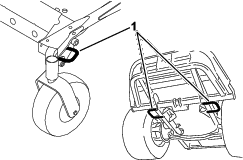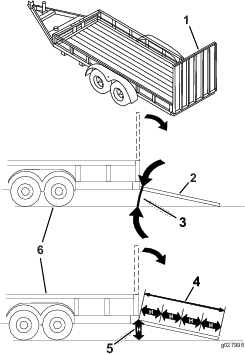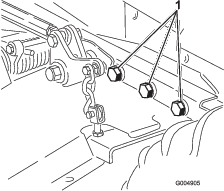Maintenance
Note: Determine the left and right sides of the machine from the normal operating position.
Note: Looking for an Electrical Schematic or Hydraulic Schematic for your machine? Download a free copy of the schematic by visiting www.Toro.com and searching for your machine from the Manuals link on the home page.
Recommended Maintenance Schedule(s)
| Maintenance Service Interval | Maintenance Procedure |
|---|---|
| After the first 10 operating hours |
|
| After the first 50 operating hours |
|
| After the first 200 operating hours |
|
| Before each use or daily |
|
| Every 50 hours |
|
| Every 100 hours |
|
| Every 150 hours |
|
| Every 200 hours |
|
| Every 250 hours |
|
| Every 400 hours |
|
| Every 800 hours |
|
| Every 1,500 hours |
|
| Every 2 years |
|
Important: Refer to your Engine Operator's Manual for additional maintenance procedures. A detailed Service Manual is also available for purchase from your Authorized Toro Distributor.
Pre-Maintenance Procedures
Important: The fasteners on the covers of this machine are designed to remain on the cover after removal. Loosen all of the fasteners on each cover a few turns so that the cover is loose but still attached, then go back and loosen them until the cover comes free. This will prevent you from accidentally stripping the bolts free of the retainers.
Pre-Maintenance Safety
-
Before adjusting, cleaning, repairing, or leaving the machine, do the following:
-
Park the machine on a level surface.
-
Move the throttle switch to the low-idle position.
-
Disengage the cutting units.
-
Lower the cutting units.
-
Ensure that the traction is in neutral.
-
Engage the parking brake.
-
Shut off the engine and remove the key.
-
Wait for all moving parts to stop.
-
Allow machine components to cool before performing maintenance.
-
-
If the cutting units are in the transport position, use the positive mechanical lock (if available) before you leave the machine unattended.
-
If possible, do not perform maintenance while the engine is running. Keep away from moving parts.
-
Use jack stands to support the machine or components when required.
-
Carefully release pressure from components with stored energy.
Lubrication
Greasing the Bearings and Bushings
The machine has grease fittings that you must lubricate regularly with No. 2 lithium grease. Lubricate more often in dirty or dusty conditions because dirt can get into the bearings and bushings and cause accelerated wear.
-
Wipe the grease fittings clean so that foreign matter cannot be forced into the bearing or bushing.
-
Pump grease into the fittings.
-
Wipe off excess grease.
Note: Improper wash-down procedures can negatively affect bearing life. Do not wash down the machine when it is still hot and avoid directing high-pressure or high-volume spray at the bearings or seals.
Close sectionServicing the Mower-Deck Gear Box Lubricant
The gear box is designed to operate with SAE EP90W gear lube. Although the gear box comes from the factory with lubricant, check the level of the lubricant in the cutting unit before operating it and as recommended in the Daily Maintenance Checklist.
Checking the Mower-Deck Gearbox Lubricant
-
Position the machine and mower deck on a level surface.
-
Lower the mower deck to the 2.5 cm (1 inch) height of cut.
-
Disengage the PTO, move the motion-control levers to the NEUTRAL-LOCK position, and engage the parking brake.
-
Move the throttle lever to the SLOW position, shut off the engine, remove the key, and wait for all moving parts to stop before leaving the operating position.
-
Lift the footrest, exposing the top of the mower deck.
-
Remove the dipstick/fill plug from the top of the gearbox and make sure that the lubricant is between the marks on the dipstick (Figure 58).
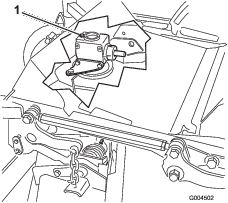
-
If the lubricant level is low, add enough lubricant until the level is between the marks on the dipstick.
Important: Do not overfill the gearbox; overfilling the gearbox may damage it.
Changing the Mower-Deck Gearbox Lubricant
-
Position the machine and cutting unit on a level surface.
-
Lower the mower deck to the 2.5 cm (1 inch) height of cut.
-
Disengage the PTO, move the motion-control levers to the NEUTRAL-LOCK position, and engage the parking brake.
-
Move the throttle lever to the SLOW position, shut off the engine, remove the key, and wait for all moving parts to stop before leaving the operating position.
-
Lift the footrest, exposing the top of the mower deck.
-
Remove the dipstick/fill plug from the top of the gearbox (Figure 58).
-
Place a funnel and drain pan under the drain plug located under the front of the gearbox and remove the plug, draining the lubricant into the pan.
-
Replace the drain plug.
-
Add enough lubricant, approximately 283 ml (12 oz), until the level is between the marks on the dipstick.
Important: Do not overfill the gearbox; overfilling the gearbox may damage it.
Engine Maintenance
Engine Safety
-
Shut off the engine before checking the oil or adding oil to the crankcase.
-
Do not change the governor speed or overspeed the engine.
Checking the Air Cleaner
-
Check the air-cleaner body for damage, which could possibly cause an air leak. Replace a damaged air-cleaner body.
-
Check the air-intake system for leaks, damage, or loose hose clamps.
-
Service the air-cleaner filter when the air-cleaner indicator shows red and service it more frequently in extremely dusty or dirty conditions (Figure 59).
Important: Do not over-service the air filter.
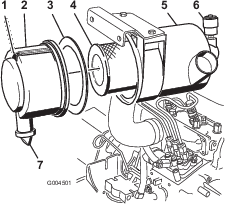
-
Be sure that the cover is seated correctly and seals with the air-cleaner body.
Servicing the Air Cleaner
Note: If the foam gasket in the cover is damaged, replace it.
Important: Avoid using high-pressure air, which could force dirt through the filter into the intake tract.
Important: Do not clean the used filter to avoid damage to the filter media.
Important: Do not use a damaged filter.
Important: Do not apply pressure to the flexible center of the filter.
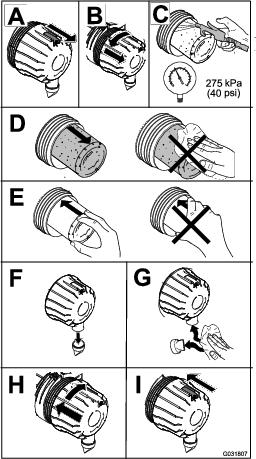
Servicing the Engine Oil
Oil Specification
Use high-quality, low-ash engine oil that meets or exceeds the following specifications:
-
API service category CJ-4 or higher
-
ACEA service category E6
-
JASO service category DH-2
Important: Using engine oil other than API CJ-4 or higher, ACEA E6, or JASO DH-2 may cause the diesel particulate filter to plug or cause engine damage.
Use the following engine oil viscosity grade:
-
Preferred oil: SAE 15W-40 (above 0°F)
-
Alternate oil: SAE 10W-30 or 5W-30 (all temperatures)
Toro Premium Engine Oil is available from your Authorized Toro Distributor in either 15W-40 or 10W-30 viscosity grades. See the parts catalog for part numbers.
Close sectionChecking the Engine-Oil Level
The engine is shipped with oil in the crankcase; however, the oil level must be checked before and after the engine is first started.
Important: Check the engine oil daily. If the engine-oil level is above the Full mark on the dipstick, the engine oil may be diluted with fuel;If the engine oil level is above the Full mark, change the engine oil.
The best time to check the engine oil is when the engine is cool before it has been started for the day. If it has already been run, allow the oil to drain back down to the sump for at least 10 minutes before checking. If the oil level is at or below the Add mark on the dipstick, add oil to bring the oil level to the Full mark. Do not overfill the engine with oil.
Important: Keep the engine oil level between the upper and lower limits on the dipstick; the engine may fail if you run it with too much or too little oil.
-
Park the machine on a level surface.
-
Unlock the hood latches and open the hood.
-
Remove the dipstick, wipe it clean, install the dipstick into the tube, and pull it out again.
The oil level should be in the safe range (Figure 61).
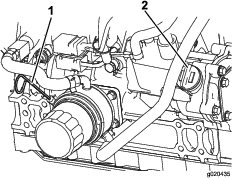
-
If the oil is below the safe range, remove the fill cap (Figure 61) and add oil until the level reaches the Full mark.
Important: Do not overfill the engine with oil.
Note: When using different oil, drain all old oil from the crankcase before adding new oil.
-
Install the oil-fill cap and dipstick.
-
Close the hood and secure it with the latches.
Crankcase Oil Capacity
5.2 liters (5.5 qt) with the filter.
Close sectionChanging the Engine Oil And Filter
Change the oil and filter every 250 hours.
-
Remove the engine oil drain plug (Figure 62) and let the oil flow into a drain pan. When all the oil is drained, install the drain plug.
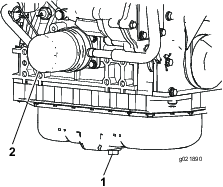
-
Remove the oil filter (Figure 62). Apply a light coat of clean oil to the new filter seal before screwing it on. Do not overtighten.
-
Add oil to the crankcase; refer to Checking the Engine Oil.
Servicing the Diesel-Oxidation Catalyst (DOC) and the Soot Filter
-
If advisory message displays in the InfoCenter, the DPF is nearing the recommended point for servicing the diesel-oxidation catalyst and the soot filter.

-
If engine faults , , or in the InfoCenter (Figure 64) display in the InfoCenter, clean the soot filter using the steps that follow:



-
Refer to the Engine section in the Service Manual for information on disassembling and assembling the diesel-oxidation catalyst and the soot filter of the DPF.
-
Refer to your Authorized Toro Distributor for diesel-oxidation catalyst and the soot filter replacement parts or service.
-
Contact your Authorized Toro Distributor to have them reset the engine ECU after you install a clean DPF.
-
Fuel System Maintenance
Note: Refer to Fuel Specification for proper fuel recommendations.
Danger
Under certain conditions, diesel fuel and fuel vapors are highly flammable and explosive. A fire or explosion from fuel can burn you and others and can cause property damage.
-
Use a funnel and fill the fuel tank outdoors, in an open area, when the engine is off and is cold. Wipe up any fuel that spills.
-
Do not fill the fuel tank completely full. Add fuel to the fuel tank until the level is to the bottom of the filler neck.
-
Never smoke when handling fuel, and stay away from an open flame or where fuel fumes may be ignited by a spark.
-
Store fuel in a clean, safety-approved container and keep the cap in place.
Servicing the Engine Fuel Filter
The engine fuel filter should be replaced after every 400 hours of operation.
-
Clean the area around the fuel filter head (Figure 65).
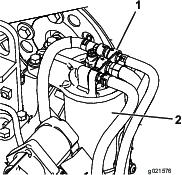
-
Remove the filter and clean the filter head mounting surface (Figure 65).
-
Lubricate the filter gasket with clean lubricating engine oil. Refer to the Engine Operator's Manual, included with the machine, for additional information.
-
Install the dry filter canister, by hand, until the gasket contacts the filter head, then rotate it an additional 1/2 turn.
-
Start the engine and check for fuel leaks around the filter head.
Servicing the Water Separator
Cleaning the Fuel Tank
Remove and clean the in-line strainers after draining the tank. Use clean diesel fuel to flush out the tank.
Important: Drain and clean the tank if the fuel system becomes contaminated or if you are storing the machine for an extended period.
Close sectionChecking the Fuel Lines and Connections
Inspect the fuel lines for deterioration, damage, chaffing, or loose connections.
Close sectionElectrical System Maintenance
Electrical System Safety
-
Disconnect the battery before repairing the machine. Disconnect the negative terminal first and the positive last. Connect the positive terminal first and the negative last.
-
Charge the battery in an open, well-ventilated area, away from sparks and flames. Unplug the charger before connecting or disconnecting the battery. Wear protective clothing and use insulated tools.
Warning
Battery posts, terminals, and related accessories contain lead and lead compounds, chemicals known to the State of California to cause cancer and reproductive harm. Wash hands after handling.
Servicing the Battery
Keep the top of the battery clean. If you store the machine in a location where temperatures are extremely high, the battery will run down more rapidly than if the machine is stored in a location where the temperature is cool.
Keep the top of the battery clean by washing it periodically with a brush dipped in ammonia or bicarbonate of soda solution. Flush the top surface with water after cleaning it. Do not remove the fill caps while cleaning the battery.
The battery cables must be tight on the terminals to provide good electrical contact.
If corrosion occurs at the terminals, disconnect the cables, negative (-) cable first, and scrape the clamps and terminals separately. Connect the cables, positive (+) cable first, and coat the terminals with petroleum jelly.
Warning
Battery terminals or metal tools could short against metal machine components causing sparks. Sparks can cause the battery gasses to explode, resulting in personal injury.
-
When removing or installing the battery, do not allow the battery terminals to touch any metal parts of the machine.
-
Do not allow metal tools to short between the battery terminals and metal parts of the machine.
Warning
Incorrect battery cable routing could damage the machine and cables causing sparks. Sparks can cause the battery gasses to explode, resulting in personal injury.
-
Always disconnect the negative (black) battery cable before disconnecting the positive (red) cable.
-
Always connect the positive (red) battery cable before connecting the negative (black) cable.
Storing the Battery
If you are storing the machine more than 30 days, remove the battery and charge it fully. Either store it on a shelf or on the machine. Do not connect the cables if you store it on the machine. Store the battery in a cool environment to prevent the battery from discharging rapidly. To prevent the battery from freezing, make sure it is fully charged. The specific gravity of a fully charged battery is 1.265 to 1.299.
Close sectionChecking the Fuses
The fuses are located under the control panel. Access them through the side panel cover (Figure 67). To open the side panel cover, release the 2 latches and pull out on it.
If the machine stops or has other electrical system issues, check the fuses. Grasp each fuse in turn and remove them 1 at a time, checking if any are blown.
Important: If you need to replace a fuse, always use the same type and amperage-rated fuse as the one you are replacing, otherwise you could damage the electrical system. Refer to the decal next to the fuses for a diagram of each fuse and its amperage (Figure 68).
Note: If a fuse blows frequently, you probably have a short in the electrical system and should have it serviced by a qualified service technician.
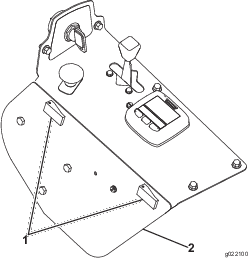

Drive System Maintenance
Checking the Tire Pressure
Maintain the air pressure in the front and rear tires (Figure 69). The correct air pressure is 124 kPa (15 psi) in the rear tires and 103 kPa (25 psi) in the caster wheels. Uneven tire pressure can cause an uneven cut.
Note: Check the tires when they are cold to get the most accurate pressure reading.
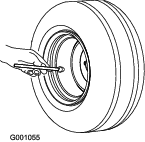
Replacing the Caster Wheels and Bearings
-
Obtain a new caster-wheel assembly, cone bearings, and bearing seals from your Authorized Toro Distributor.
-
Remove the locknut from the bolt (Figure 70).
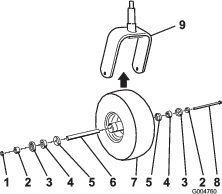
-
Grasp the caster wheel and slide the bolt out of the fork or pivot arm.
-
Discard the old caster wheel and bearings.
-
Assemble the caster wheel by pushing the cone bearings and seals, packed with grease, into the wheel hub, positioned as shown in Figure 70.
-
Slide the spacer into the wheel hub through the bearings, captivating the spacer inside the wheel hub with 2 bearing spacers.
Important: Ensure that the seal lips are not folded inward.
-
Install the caster-wheel assembly between the castor fork and secure it in place with the bolt and locknut.
-
Tighten the locknut until the wheel no longer spins freely, then back it off just until the wheel spins freely.
-
Attach a grease gun to the grease fitting on the caster wheel and fill it with No. 2 lithium grease.
Cooling System Maintenance
Cooling System Safety
-
Swallowing engine coolant can cause poisoning; keep out of reach from children and pets.
-
Discharge of hot, pressurized coolant or touching a hot radiator and surrounding parts can cause severe burns.
-
Always allow the engine to cool at least 15 minutes before removing the radiator cap.
-
Use a rag when opening the radiator cap, and open the cap slowly to allow steam to escape.
-
Checking the Cooling System
The cooling system is filled with a 50/50 solution of water and permanent ethylene glycol anti freeze. The capacity of the cooling system is 7.5 L (6 US qt).
-
Check the level of the coolant in the expansion tank (Figure 71).
Note: The coolant level should be between the marks on the side of the tank.
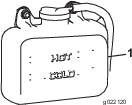
-
If coolant level is low, remove the expansion-tank cap and replenish the system.
Important: Do not overfill.
-
Install the expansion-tank cap.
Cleaning the Radiator
Clean the radiator to prevent the engine from overheating.
Note: If the mower deck or engine shuts off due to overheating, check the radiator for excessive buildup of debris.
Clean the radiator as follows:
-
Open the hood.
-
Working from the fan side of the radiator, blow out debris with low pressure (345 kPa or 50 psi), compressed air. Repeat from the front of the radiator and the other fan side.
Important: Do not use water.
-
After you thoroughly clean the radiator, clean out debris that may have collected in the channel at the radiator base.
-
Close the hood.
Brake Maintenance
Adjusting the Parking-Brake Interlock Switch
-
Stop the machine, move the motion-control levers to the NEUTRAL-LOCK position, engage the parking brake, and remove the ignition key.
-
Remove the bolts securing the front panel and remove the panel (Figure 72).
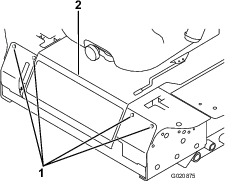
-
Loosen the 2 jam nuts securing the parking-brake interlock switch to the mounting bracket.
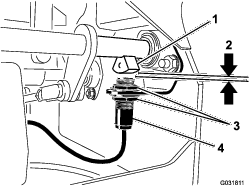
-
Move the switch up or down on the bracket until the distance between the brake-shaft sensor and the switch plunger is 4 mm (5/32 inch) as shown in Figure 73.
Note: Make sure that the brake-shaft sensor does not contact the switch plunger.
-
Secure the switch jam nuts.
-
Test the adjustment as follows:
-
Ensure that the parking brake is engaged and you are not sitting on the seat, then start the engine.
-
Move the control levers out of the NEUTRAL-LOCK position.
Note: The engine should shut off. If not, check the adjustment that you made to the switch.
-
-
Install the front panel.
Belt Maintenance
Checking the Alternator-Belt Tension
-
Apply 44 N (10 lb) of force to the alternator belt, midway between the pulleys.
-
If the deflection is not 10mm (3/8inch), loosen the alternator mounting bolts (Figure 74).
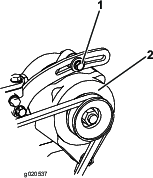
-
Increase or decrease the alternator-belt tension.
-
Tighten the mounting bolts.
-
Check the deflection of the belt again to ensure that the tension is correct.
Controls System Maintenance
Adjusting the Control-Lever Neutral-Interlock Switch
-
Stop the machine, move the motion-control levers to the NEUTRAL-LOCK position, engage the parking brake, and remove the ignition key.
-
Remove the bolts securing the front panel and remove the panel (Figure 75).

-
Loosen the 2 screws securing the interlock switch (Figure 76).
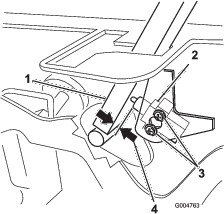
-
Holding the control lever against the frame, move the switch toward the lever until the distance between the lever and switch body is 0.4 to 1 mm (0.015 to 0.045 inch) as shown in Figure 76.
-
Secure the switch.
-
Repeat steps 3 to 5 for the other lever.
-
Install the front panel.
Adjusting the Control-Lever Neutral Return
If the motion-control levers do not align with the neutral slots when released from the REVERSE position, adjustment is required. Adjust each lever, spring, and rod separately.
-
Disengage the PTO, move the control lever to the NEUTRAL-LOCK position, and engage the parking brake.
-
Move the throttle lever to the SLOW position, shut off the engine, remove the key, and wait for all moving parts to stop before leaving the operating position.
-
Remove the bolts securing the front panel and remove the panel (Figure 77).

-
Move the control lever to the NEUTRAL position but not locked (Figure 79).
-
Pull the lever back until the clevis pin (on an arm above the pivot shaft) contacts the end of the slot (just beginning to put pressure on the spring) as shown in Figure 78.
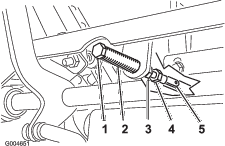
-
Check where the control lever is relative to notch in the console (Figure 79).
Note: The control lever should be centered, allowing lever to pivot outward to the NEUTRAL-LOCK position.
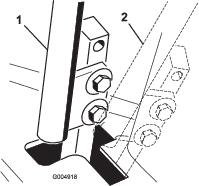
-
If adjustment is needed, loosen the nut and jam nut against the yoke (Figure 78).
-
Applying slight rearward pressure on the motion-control lever, turn the head of the adjustment bolt in the appropriate direction until the control lever is centered in the NEUTRAL-LOCK position (Figure 78).
Note: Rearward pressure on the lever keeps the pin at the end of the slot and allow the adjustment bolt to move the lever to the appropriate position.
-
Tighten the nut and jam nut (Figure 78).
-
Repeat steps 4 through 9 for the other control lever.
-
Install the front panel.
Adjusting the Traction Drive for Neutral
Make this adjustment with the drive wheels turning.
Danger
Mechanical or hydraulic jacks may fail to support the machine and cause a serious injury.
-
Use jack stands when supporting the machine.
-
Do not use hydraulic jacks.
Warning
The engine must be running to perform this adjustment. Contact with moving parts or hot surfaces may cause personal injury.
Keep hands, feet, face, clothing, and other body parts away from rotating parts, muffler, and other hot surfaces.
-
Raise the frame onto stable jack stands so that the drive wheels can rotate freely.
-
Slide the seat forward, unlatch it, and swing it up and forward.
-
Disconnect the electrical connector from the seat safety switch.
-
Temporarily install a jumper wire across the terminals in the wire harness connector.
-
Start the engine, ensure that the throttle lever is midway between the FAST and SLOW positions, and release the parking brake.
Note: The motion-control levers must be in the NEUTRAL-LOCK position while you make any adjustments.
-
Adjust the pump rod length on one side by rotating the hex shaft, in the appropriate direction, until the corresponding wheel is still or slightly creeping in reverse (Figure 80).
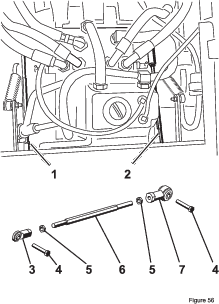
-
Move the motion-control lever forward and reverse, then back to neutral.
Note: The wheel must stop turning or slightly creep in reverse.
-
Move the throttle lever to the FAST position.
Note: Make sure that the wheel remains stopped or slightly creeps in reverse; adjust it if necessary.
-
Repeat steps 6 through 8 for the other side of the machine.
-
Tighten the jam nuts at the ball joints (Figure 78).
-
Move the throttle lever to the SLOW position and shut off the engine.
-
Remove the jumper wire from the wire harness connector and plug the connector into the seat switch.
Warning
The electrical system does not perform proper safety shutoff with the jumper wire installed.
-
Remove the jumper wire from the wire harness connector and plug the connector into the seat switch when you complete adjustment.
-
Never operate the machine with the jumper installed and the seat switch bypassed.
-
-
Lower the seat into position.
-
Remove the jack stands.
Adjusting the Maximum Ground Speed
-
Disengage the PTO, move the motion-control levers to the NEUTRAL-LOCK position, and engage the parking brake.
-
Move the throttle lever to the SLOW position, shut off the engine, remove the key, and wait for all moving parts to stop before leaving the operating position.
-
Remove the bolts securing the front panel and remove the panel (Figure 81).

-
Loosen the jam nut on the stop bolt for a control lever (Figure 82).

-
Thread the stop bolt all the way in (away from the control lever).
-
Push the control lever all the way forward until it stops and hold it there.
-
Thread the stop bolt out (toward the control lever) until there is a gap of 1.5 mm (0.060 inch) between the head of the stop bolt and the control lever.
Note: If you want to reduce the maximum machine speed, back each stop bolt out an equal amount toward the control lever until you reach the desired maximum speed. You may need to test your adjustment several times.
-
Tighten the jam nut to secure the stop bolt in place.
-
Repeat steps 4 through 8 for the other control lever.
-
Install the front panel.
-
Ensure that the machine drives straight and does not turn when both control levers are pushed all the way forward.
Note: If the machine turns, the stop bolts are not evenly set and you need to adjust them further.
Adjusting the Tracking
-
Disengage the PTO, move the motion-control levers to the NEUTRAL-LOCK position, and engage the parking brake.
-
Move the throttle lever to the SLOW position, shut off the engine, remove the key, and wait for all moving parts to stop before leaving the operating position.
-
Loosen the bolts securing the control levers (Figure 83).

-
Have someone push the control-lever posts (not the control levers) all the way forward into the maximum-speed position and hold them there.
-
Adjust the control levers so that they line up and tighten the bolts, securing the levers to the posts (Figure 84).

Hydraulic System Maintenance
The reservoir is filled at the factory with approximately 4.7liters (5quarts) of high quality tractor transmission/hydraulic fluid. The recommended replacement fluid is as follows:
| Toro Premium Transmission/Hydraulic Tractor Fluid (Available in 5 gallon pails or 55 gallon drums. See parts catalog or Toro distributor for part numbers.) |
Alternate fluids: If the Toro fluid is not available, Mobil® 424 hydraulic fluid may be used.
Note: Toro will not assume responsibility for damage caused by improper substitutions.
Note: Many hydraulic fluids are almost colorless, making it difficult to spot leaks. A red dye additive for the hydraulic system oil is available in 20ml (2/3oz) bottles. One bottle is sufficient for 15-22 liters (4-6 gallons) of hydraulic fluid. Order part number 44-2500 from your Authorized Toro Distributor.
Hydraulic System Safety
-
Ensure that all hydraulic-fluid hoses and lines are in good condition and all hydraulic connections and fittings are tight before applying pressure to the hydraulic system.
-
Keep your body and hands away from pinhole leaks or nozzles that eject high-pressure hydraulic fluid.
-
Use cardboard or paper to find hydraulic leaks.
-
Safely relieve all pressure in the hydraulic system before performing any work on the hydraulic system.
-
Seek immediate medical attention if fluid is injected into skin. Injected fluid must be surgically removed within a few hours by a doctor.
Checking the Hydraulic System
Check the level of the hydraulic fluid before you first start the engine and daily thereafter.
-
Position the machine on a level surface.
-
Move the motion-control levers to the NEUTRAL-LOCK position and start the engine.
Note: Run the engine at the lowest possible rpm to purge the system of air.
Important: Do not engage the PTO.
-
Raise the deck to extend the lift cylinders, shut off the engine, and remove the key.
-
Raise the seat to access the hydraulic fluid tank.
-
Remove the hydraulic fill cap from the filler neck (Figure 85).
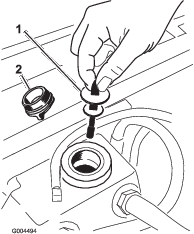
-
Remove the dipstick and wipe it with a clean rag (Figure 85).
-
Place the dipstick into the filler neck; then remove it and check the level of fluid (Figure 85).
Note: If the level is not within the notched area of the dipstick, add enough high-quality hydraulic fluid to raise the level to within the notched area.
Important: Do not overfill.
-
Replace the dipstick and thread the fill cap finger-tight onto the filler neck.
-
Check all hoses and fittings for leaks.
Changing the Hydraulic Fluid And Filter
-
Disengage the PTO, move the motion-control levers to the NEUTRAL-LOCK position, and engage the parking brake.
-
Move the throttle lever to the SLOW position, shut off the engine, remove the key, and wait for all moving parts to stop before leaving the operating position.
-
Place a large pan under the hydraulic reservoir and transmission case and remove the plugs, draining all of the hydraulic fluid (Figure 86).
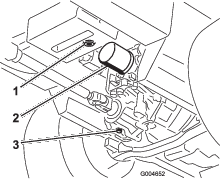
-
Clean the area around the hydraulic fluid filter and remove the filter (Figure 86).
-
Immediately install a new hydraulic fluid filter.
-
Install the hydraulic-reservoir and transmission-case drain plugs.
-
Fill the reservoir to the proper level (approximately 5.7 L or 6 US qt); refer to Checking the Hydraulic System.
-
Start the engine and check for oil leaks. Allow the engine to run for about 5 minutes, then shut it off.
-
After 2 minutes, check the level of the hydraulic fluid; refer to Checking the Hydraulic System.
Cleaning Under the Mower
-
Disengage the PTO, move the motion-control levers to the NEUTRAL-LOCK position, and engage the parking brake.
-
Move the throttle lever to the SLOW position, shut off the engine, remove the key, and wait for all moving parts to stop before leaving the operating position.
-
Raise the mower to the transport position.
-
Raise the front of the machine using jack stands.
-
Thoroughly clean the underside of the mower with water.
Disposing of Waste
Engine oil, batteries, hydraulic fluid, and engine coolant are pollutants. Dispose of these according to your state and local regulations.
Close section
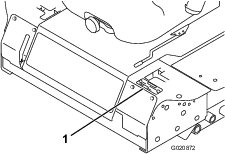

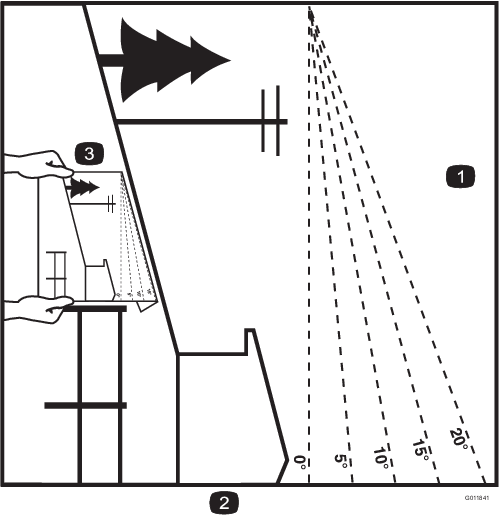

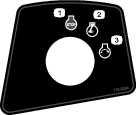



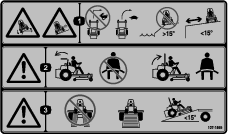


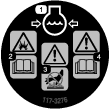
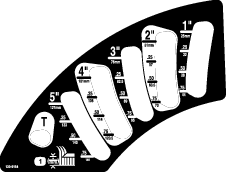
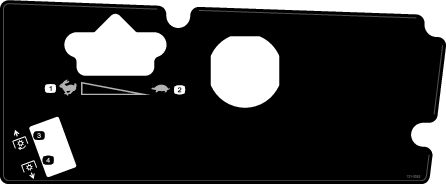


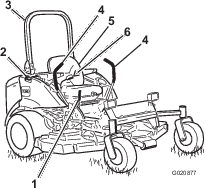
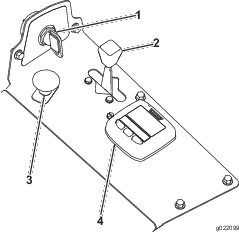
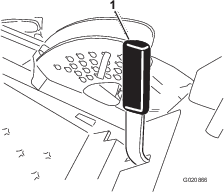
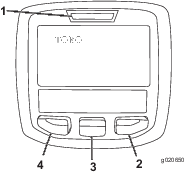



























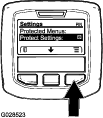
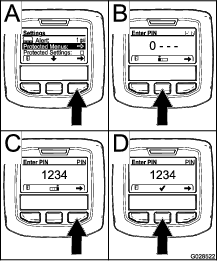
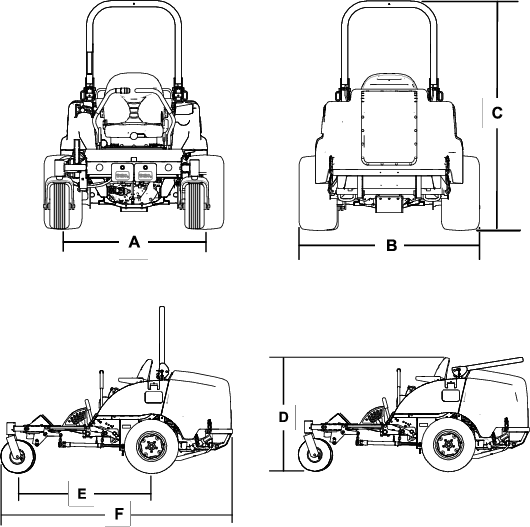
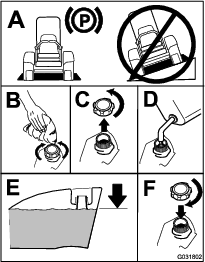

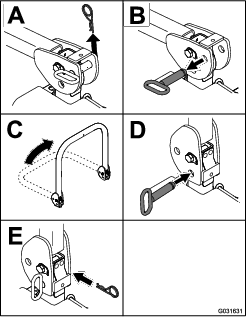

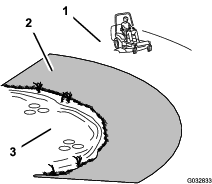

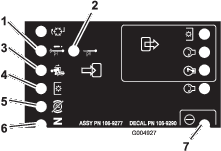
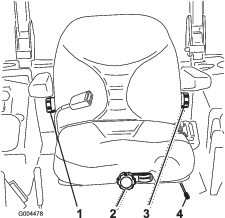
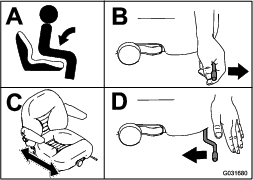
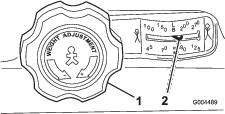
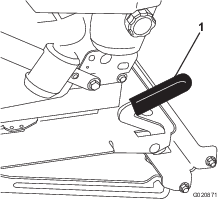
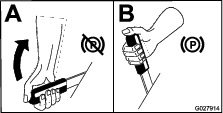
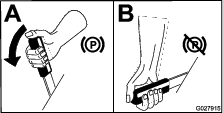
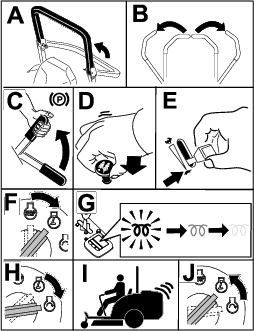

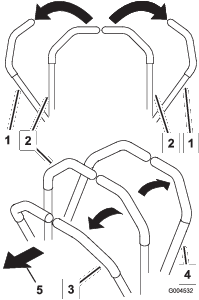
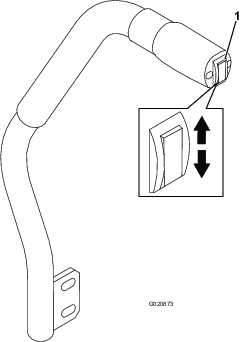


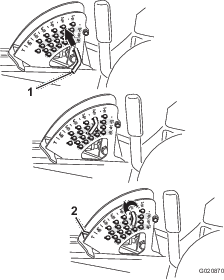


 is displayed in the InfoCenter,
an assist regeneration is in progress.
is displayed in the InfoCenter,
an assist regeneration is in progress. is displayed in the InfoCenter,
a regeneration is in progress.
is displayed in the InfoCenter,
a regeneration is in progress. is displayed in the InfoCenter,
a regeneration is requested.
is displayed in the InfoCenter,
a regeneration is requested. is displayed in the InfoCenter,
a recovery regeneration is requested.
is displayed in the InfoCenter,
a recovery regeneration is requested.
 icon displays in the InfoCenter while the assist
regeneration is processing.
icon displays in the InfoCenter while the assist
regeneration is processing.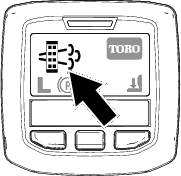
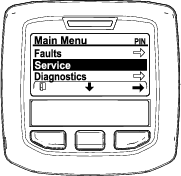
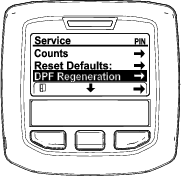

 is running and above 60C/140F message displays. (
is running and above 60C/140F message displays. (